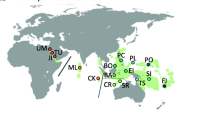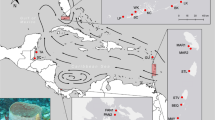Abstract
Quantifying patterns of gene flow is critical for predicting the future resilience of local marine communities. Brooding species may be particularly susceptible to extirpation, as the lack of a pelagic larval phase may limit dispersal capacity and increase the risk of local extinction. Here, we investigate the population genetic structure of Leptasterias sp., a brooding sea star and important intertidal predator. Dispersal in this genus occurs primarily by crawling, but some have suggested that occasional “rafting” events can move individuals long distances. We used microsatellite markers to estimate genotypic variation across six collection sites of varying distances apart along the Oregon coast. We found evidence of strong population structure at the level of capes, and especially high divergence between two sites within Cape Blanco. Although cape-level genetic structure is broadly consistent with isolation-by-distance, additional mechanisms may be required to explain the elevated magnitude of genetic divergence on a finer scale. We propose that a known offshore water jet off Cape Blanco may act as phylogeographic barrier, hindering transport of rafting individuals from neighboring sites. This pattern suggests, indirectly, that rafting may be more important than previously appreciated in generating long-term genetic isolation between nearby sites. Our findings suggest that even for a sessile brooding species, connectivity and genetic structure can vary on a fine spatial scale and may be subject to environmental and oceanographic forces.



Similar content being viewed by others
Data availability
Microsatellite genotypes are available in the supplementary information. Oceanographic current vector data and sediment map data are cited as [datasets] in bibliography.
References
Barbosa SS, Klanten SO, Puritz JB, Toonen RJ, Byrne M (2013) Very fine-scale population genetic structure of sympatric asterinid sea stars with benthic and pelagic larvae: influence of mating system and dispersal potential. Biol J Linn Soc 108(4):821–833. https://doi.org/10.1111/bij.12006
Barreto FS, Bauer KK (2019) Genetic evidence for alloparental care and frequent multiple paternity in the brooding sea star (Leptasterias sp). Mar Biol 166(3):38. https://doi.org/10.1007/s00227-019-3487-3
Barth J, Pierce S, Smith R (2000) A separating coastal upwelling jet at Cape Blanco, Oregon and its connection to the California current system. Deep Sea Res Part II 47(5):783–810. https://doi.org/10.1016/S0967-0645(99)00127-7
Barth JA, Menge BA, Lubchenco J, Chan F, Bane JM, Kirincich AR, McManus MA, Nielsen KJ, Pierce SD, Washburn L (2007) Delayed upwelling alters nearshore coastal ocean ecosystems in the northern California current. P Natl Acad Sci USA 104(10):3719. https://doi.org/10.1073/pnas.0700462104
Beerli P, Felsenstein J (2001) Maximum likelihood estimation of a migration matrix and effective population sizes in n subpopulations by using a coalescent approach. P Natl Acad Sci USA 98:4563–4568
Beerli P, Palczewski M (2010) Unified framework to evaluate panmixia and migration direction among multiple sampling locations. Genetics 185:313–326
Bernhardt JR, Leslie HM (2013) Resilience to climate change in coastal marine ecosystems. Annu Rev Mar Sci 5(1):371–392. https://doi.org/10.1146/annurev-marine-121211-172411
Bohonak A (1999) Dispersal, gene flow, and population structure. Q Rev Biol 74(1):21–45. https://doi.org/10.1086/392950
Chan F, Barth JA, Blanchette CA, Byrne RH, Chavez F, Cheriton O et al (2017) Persistent spatial structuring of coastal ocean acidification in the California current system. Sci Rep 7(1):2526. https://doi.org/10.1038/s41598-017-02777-y
Chapuis MP, Estoup A (2007) Microsatellite null alleles and estimation of population differentiation. Mol Biol Evol 24(3):621–631
Chia FS (1966) Systematics of the six-rayed sea star, Leptasterias, in the vicinity of San Juan Island, Washington. Syst Zool 15:300–306
Conover DO, Clarke LM, Munch SB, Wagner GN (2006) Spatial and temporal scales of adaptive divergence in marine fishes and the implications for conservation. J Fish Biol 69:21–47. https://doi.org/10.1111/j.1095-8649.2006.01274.x
Cowen RK, Sponaugle S (2009) Larval dispersal and marine population connectivity. Annu Rev Mar Sci 1(1):443–466. https://doi.org/10.1146/annurev.marine.010908.163757
Flowers JM, Foltz DW (2001) Reconciling molecular systematics and traditional taxonomy in a species-rich clade of sea stars (Leptasterias subgenus Hexasterias). Mar Biol 139:475–483
Foltz DW, Nguyen AT, Kiger JR, Mah CL (2008) Pleistocene speciation of sister taxa in a North Pacific clade of brooding sea stars (Leptasterias). Mar Biol 154:593–602
Goldfinger C (2018) US. West Coast Habitat Map. OSU CEOAS Active Tectonics and Seafloor Mapping Lab, Version 4.0. http://activetectonics.coas.oregonstate.edu/downloads/V4_SGH.mpk
Grantham BA, Eckert GL, Shanks AL (2003) Dispersal potential of marine invertebrates in diverse habitats. Ecol Appl 13(1):108–116
Gravem SA, Morgan SG (2017) Shifts in intertidal zonation and refuge use by prey after mass mortalities of two predators. Ecology 98:1006–1015
Highsmith RC (1985) Floating and algal rafting as potential dispersal mechanisms in brooding invertebrates. Mar Ecol Prog Ser 25:169–179. https://doi.org/10.3354/meps025169
Kamel S, Grosberg R, Addison J (2014) Multiscale patterns of genetic structure in a marine snail (Solenosteira macrospira) without pelagic dispersal. Mar Biol 161(7):1603–1614. https://doi.org/10.1007/s00227-014-2444-4
Keever CC, Sunday J, Puritz JB, Addison JA, Toonen RJ, Grosberg RK, Hart MW (2009) Discordant distribution of populations and genetic variation in a sea star with high dispersal potential. Evolution 63(12):3214–3227. https://doi.org/10.1111/j.1558-5646.2009.00801.x
Kirby RR, Bayne BL, Berry RJ (1994) Phenotypic variation along a cline in allozyme and karyotype frequencies, and its relationship with habitat, in the dog-whelk Nucella lapillus. L Biol J Linn Soc 53(3):255–275. https://doi.org/10.1111/j.1095-8312.1994.tb01012.x
Kosro M (2004–2020) Surface currents of the Oregon coastal ocean; Mapping Oregon Coastal Currents. http://bragg.coas.oregonstate.edu.
Kyle CJ, Boulding EG (2000) Comparative population genetic structure of marine gastropods (Littorina spp) with and without pelagic larval dispersal. Mar Biol 137(5):835–845. https://doi.org/10.1007/s002270000412
Marko PB, Hart MW (2017) Genetic analysis of larval dispersal, gene flow, and connectivity. In: Carrier T, Reitzel A, Heyland A (eds) Evolutionary ecology of marine invertebrate larvae. Oxford University Press, Oxford, USA
Marshall TC, Slate J, Kruuk LEB, Pemberton JM (1998) Statistical confidence for likelihood-based paternity inference in natural populations. Mol Ecol 7(5):639–655. https://doi.org/10.1046/j.1365-294x.1998.00374.x
Meirmans PG, Hedrick P (2011) Assessing population structure: F-ST and related measures. Mol Ecol Res 11(1):5–18. https://doi.org/10.1111/j.1755-0998.2010.02927.x
Meirmans PG, Van Tienderen PH (2004) Genotype and genodive: two programs for the analysis of genetic diversity of asexual organisms. Mol Ecol Notes 4(4):792–794. https://doi.org/10.1111/j.1471-8286.2004.00770.x
Melroy LM, Cohen CS (2021) Temporal and spatial variation in population structure among brooding sea stars in the genus Leptasterias. Ecol Evol 11:3313–3331
Melroy LM, Smith RJ, Cohen CS (2017) Phylogeography of direct-developing sea stars in the genus Leptasterias in relation to San Francisco Bay outflow in central California. Mar Biol 164(7):152. https://doi.org/10.1007/s00227-017-3184-z
Menge JL, Menge BA (1974) Role of resource allocation, aggression and spatial heterogeneity in coexistence of two competing intertidal starfish. Ecol Monogr 44:189–209
Paduan JD, Washburn L (2013) High-frequency radar observations of ocean surface currents. Annu Rev Mar Sci 5(1):115–136. https://doi.org/10.1146/annurev-marine-121211-172315
Parker T, Tunnicliffe V (1994) Dispersal strategies of the biota on an oceanic seamount: implications for ecology and biogeography. Biol Bull 187(3):336–345
Pritchard JK, Stephens M, Donnelly P (2000) Inference of population structure using multilocus genotype data. Genetics 155(2):945
Putman AI, Carbone I (2014) Challenges in analysis and interpretation of microsatellite data for population genetic studies. Ecol Evol 4:4399–4428. https://doi.org/10.1002/ece3.1305
Reimer JN, Hacker SD, Menge BA, Ruggiero P (2018) Macrophyte wrack on sandy beaches of the US Pacific Northwest is linked to proximity of rocky reefs and estuaries, ocean upwelling, and beach morphology. Mar Ecol Prog Ser 594:263–269. https://doi.org/10.3354/meps12565
Rousset F (1997) Genetic differentiation and estimation of gene flow from F-statistics under isolation by distance. Genetics 145(4):1219–1228
Rousset F (2008) genepop’007: a complete re-implementation of the genepop software for Windows and Linux. Mol Ecol Res 8(1):103–106. https://doi.org/10.1111/j.1471-8286.2007.01931.x
Sanford E, Kelly MW (2011) Local adaptation in marine invertebrates. Annu Rev Mar Sci 3:509. https://doi.org/10.1146/annurev-marine-120709-142756
Serrano X, Baums IB, O’Reilly K, Smith TB, Jones RJ, Shearer TL et al (2014) Geographic differences in vertical connectivity in the caribbean coral Montastraea cavernosa despite high levels of horizontal connectivity at shallow depths. Mol Ecol 23(17):4226–4240. https://doi.org/10.1111/mec.12861
Sokolova I, Boulding E (2004) A neutral DNA marker suggests that parallel physiological adaptations to open shore and salt marsh habitats have evolved more than once within two different species of gastropods. Mar Biol 145(1):133–147. https://doi.org/10.1007/s00227-004-1292-z
Sotka EE, Wares JP, Barth JA, Grosberg RK, Palumbi SR (2004) Strong genetic clines and geographical variation in gene flow in the rocky intertidal barnacle Balanus glandula. Mol Ecol 13(8):2143–2156. https://doi.org/10.1111/j.1365-294X.2004.02225.x
Strub P, Allen J, Huyer A, Smith R, Beardsley R (1987) Seasonal cycles of currents, temperatures, winds, and sea level over the Northeast pacific continental shelf. 35°N to 48°N. J Geophys Res Atmosph 92:1507–1526. https://doi.org/10.1029/JC092iC02p01507
Struhsaker JW (1968) Selection mechanisms associated with intraspecific shell variation in Littorina picta (Prosobranchia: Mesogastropoda). Evolution 22(3):459–480. https://doi.org/10.1111/j.1558-5646.1968.tb03986.x
Sullivan-Stack J, Menge BA (2020) Testing ecological release as a compensating mechanism for mass mortality in a keystone predator. Mar Ecol Prog Ser 637:59–69. https://doi.org/10.3354/meps13227
Sunday JM, Popovic I, Palen WJ, Foreman MGG, Hart MW (2014) Ocean circulation model predicts high genetic structure observed in a long-lived pelagic developer. Mol Ecol 23(20):5036–5047. https://doi.org/10.1111/mec.12924
Untersee S, Pechenik J (2007) Local adaptation and maternal effects in two species of marine gastropod (genus Crepidula) that differ in dispersal potential. Mar Ecol Prog Ser 347:79–85. https://doi.org/10.3354/meps07063
Van Oosterhout C, Hutchinson WF, Wills DPM, Shipley P (2004) Micro-checker: software for identifying and correcting genotyping errors in microsatellite data. Mol Ecol Notes 4(3):535–538. https://doi.org/10.1111/j.1471-8286.2004.00684.x
Weir BS, Cockerham CC (1984) Estimating F-statistics for the analysis of population structure. Evolution 38(6):1358–1370. https://doi.org/10.1111/j.1558-5646.1984.tb05657.x
Wright S (1931) Evolution in Mendelian populations. Genetics 16(2):97
Wright S (1943) Isolation by distance. Genetics 28(2):114
Acknowledgements
We wish to thank J. Barth for guidance on oceanographic analysis, S. Hamilton for preparation of geospatial map figures, and J. Robinson, B. Poirson, S. Gravem, L. Fields, S. Bachhuber, and K. Bauer for assistance in fieldwork and sampling.
Funding
This work supported by the National Science Foundation Graduate Research Fellowship (award number 1840998) to ELB, and from Oregon State University startup funds to FSB.
Author information
Authors and Affiliations
Contributions
ELB, FSB, and BAM designed the research. ELB carried out field sampling and performed lab work with the assistance of FSB. ELB and FSB analyzed the data. ELB, FSB, and BAM wrote the manuscript.
Corresponding author
Ethics declarations
Conflict of interest
The authors declare that they have no conflict of interest.
Ethical approval
All applicable international, national, and/or institutional guidelines for the care and use of animals were followed. This article does not contain any studies with human participants performed by any of the authors.
Additional information
Responsible Editor: S. Uthicke.
Publisher's Note
Springer Nature remains neutral with regard to jurisdictional claims in published maps and institutional affiliations.
Supplementary Information
Below is the link to the electronic supplementary material.
Rights and permissions
Springer Nature or its licensor (e.g. a society or other partner) holds exclusive rights to this article under a publishing agreement with the author(s) or other rightsholder(s); author self-archiving of the accepted manuscript version of this article is solely governed by the terms of such publishing agreement and applicable law.
About this article
Cite this article
Boring, E.L., Menge, B.A. & Barreto, F.S. Genetic evidence for multiple dispersal mechanisms in a marine direct developer, Leptasterias sp. (Echinodermata: Asteroidea). Mar Biol 170, 137 (2023). https://doi.org/10.1007/s00227-023-04281-6
Received:
Accepted:
Published:
DOI: https://doi.org/10.1007/s00227-023-04281-6




